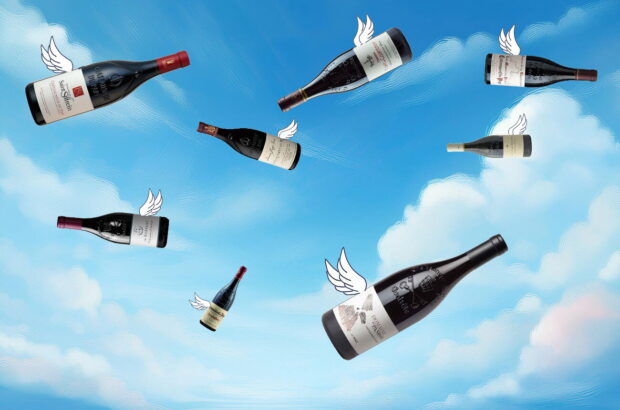French wine's increasingly effective lobbying arm is called Vin et Société. After a tendentious success in October last year, it has recently launched a new campaign – to try to clarify some of the vagaries of interpretation surrounding the Loi Evin. This one deserves complete victory.
A 2005 CIVB advertising campaign for Bordeaux wines
France’s Loi Evin came into being in January 1991. It was designed to constrain tobacco use (and was well ahead of the European curve in banning smoking in public places) and alcohol abuse (alcohol consumption has dropped in France by 20 per cent in the two decades to 2010).
The main problem with the Loi Evin is not its laudable aims, but the fatal imprecision of its statutes. This imprecision particularly applies to what might or might not be construed as ‘advertising’ or ‘promotion’, and in practice it has fallen to individual judges to position the boundaries in a series of test cases. It came into being, moreover, in a pre-internet world, and the new media has thrown up a multitude of further interpretive challenges. The results have often been hilarious.
The French are often assumed (outside France) to be merry law-flouters. In fact, the opposite is true: everyone here seems terrified of breaking the rules, and France is a jurisprudential jungle. Those with power of decision tend interpret the Loi Evin with maximum severity – or caution, to give them the benefit of the doubt.
A 2005 CIVB advertising campaign for Bordeaux wines (see picture) has been in and out of the courts for the last nine years. It shows some of the more photogenic members of Bordeaux’s wine community doing no more than twirl a glass of wine, but is considered by an organization called ANPAA (Association Nationale de Prévention en Alcoologie et Addictologie) to infringe the Loi Evin, since it “exerts on the reader a psychological action whose nature incites him or her to consume”. No matter that the slogan on the original CIVB campaign was ‘drink less but better’. ANPAA has repeatedly batted the campaign back to the courts. (As fellow blogger Hervé Lalau points out, the ANPAA is addicted to litigation.)
The French Post Office (La Poste) had a neat offer last Christmas whereby you could submit your own photos and have them printed up on sheets of stamps for personal or commercial use. Jean-Michel Chartron submitted an exquisite shot of Chevaliers-Montrachet in the snow, viewed through the stone arch at the edge of the vineyard – and not a glass of wine, nor a photogenic drinker, in sight. But no: La Poste didn’t dare reproduce the image, just in case it tiptoed over the amorphous and elephantine feet of the Loi Evin.
Paris Match and LVMH tripped over those same feet in March last year (and once again the plaintiff was the tireless ANPAA) after it published a series of celebrity photographs showing Scarlett Johansson, Helena Bonham Carter, Colin Firth and Matt Damon either holding bottles or serving glasses of Moët et Chandon Champagne. Ah ha! This was evidently ‘illicit advertising’. No matter that the text gushed “the actress sparkles for Moët et Chandon, images to devour with the eyes but bubbles to consume in moderation”: all this froth might well exert on the reader ‘a psychological action whose nature might incite him or her to consume’.
As Vin et Société makes clear, much of the ambiguity surrounding the Loi Evin is self-defeating. It’s actually hard to promote moderate wine drinking when you are constrained, in your communications, to avoid any reference to drinking at all. Those who want to promote wine drinking (which, when drunk in moderation with food, is the healthiest manner of ingesting alcohol) are hamstrung by the fact that they cannot link wine consumption to positive messages. Worst of all, the climate of fear created by the ambiguities of the law leads to publishers and broadcast media retreating, in anxious self-censure, from wine coverage. Perhaps needlessly – but who fancies the legal bills if the ANPAA tanks come and park on your lawn?
I’m optimistic, though, that French legislators will get back to work on the Loi Evin, and put a stop to the nonsense perpetrated in its name. Indeed, France’s anti-wine tide may be turning. On February 19th this year, the economic affairs committee of France’s upper-house senate unanimously adopted, across party lines, an amendment recognising “that wine, a product of the vine, and wine-producing terroirs are part of the cultural, gastronomic and landscape patrimony of France” – a significant symbolic moment. Former agriculture minister Bruno Le Maire is backing Vin et Société’s campaign to redraft what he describes as ‘a badly tangled law’.
And that final ANPAA lunge at Bordeaux’s good-looking growers was also definitively rejected, in terms which suggest that at least some of France’s judiciary have a sense of humour. “Advertisers evidently cannot be required, under the pretext of satisfying legal exigencies, to portray grumpy people of unpleasant and seemingly doubtful appearance, in order to dissuade consumers from any temptation to excess. The images used of a profession in which young people are involved, and which is open to women, and in search of modernity is fully in accord with the legal dispositions authorising reference to human factors linked to an appellation d’origine.” Let the cameras roll.
Read Jefford’s column: Wine Exceptionalism discussing the Loi Evin from October 2013
Written by Andrew Jefford







